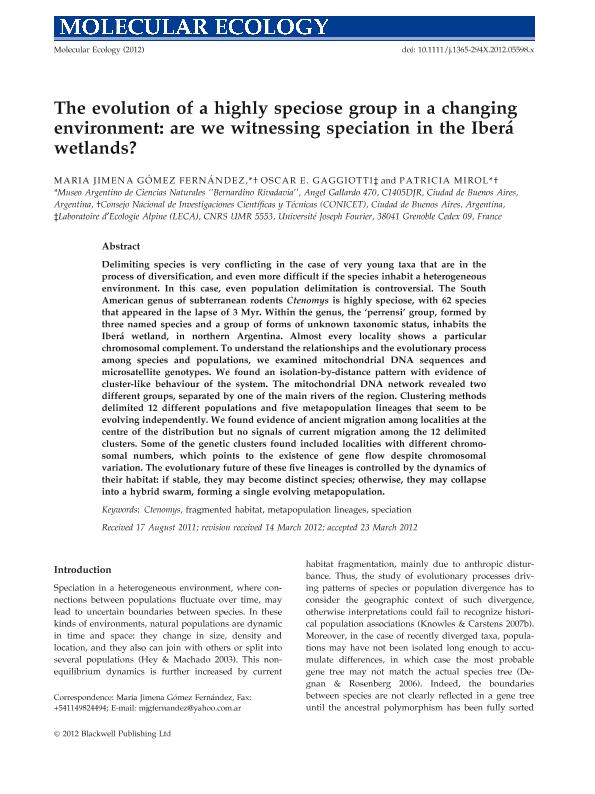Mostrar el registro sencillo del ítem
dc.contributor.author
Gomez Fernandez, Maria Jimena

dc.contributor.author
Gaggiotti, Oscar E.
dc.contributor.author
Mirol, Patricia Monica

dc.date.available
2019-01-10T15:13:58Z
dc.date.issued
2012-07
dc.identifier.citation
Gomez Fernandez, Maria Jimena; Gaggiotti, Oscar E.; Mirol, Patricia Monica; The evolution of a highly speciose group in a changing environment: Are we witnessing speciation in the Iberá wetlands?; Wiley Blackwell Publishing, Inc; Molecular Ecology; 21; 13; 7-2012; 3266-3282
dc.identifier.issn
0962-1083
dc.identifier.uri
http://hdl.handle.net/11336/67900
dc.description.abstract
Delimiting species is very conflicting in the case of very young taxa that are in the process of diversification, and even more difficult if the species inhabit a heterogeneous environment. In this case, even population delimitation is controversial. The South American genus of subterranean rodents Ctenomys is highly speciose, with 62 species that appeared in the lapse of 3 Myr. Within the genus, the 'perrensi' group, formed by three named species and a group of forms of unknown taxonomic status, inhabits the Iberá wetland, in northern Argentina. Almost every locality shows a particular chromosomal complement. To understand the relationships and the evolutionary process among species and populations, we examined mitochondrial DNA sequences and microsatellite genotypes. We found an isolation-by-distance pattern with evidence of cluster-like behaviour of the system. The mitochondrial DNA network revealed two different groups, separated by one of the main rivers of the region. Clustering methods delimited 12 different populations and five metapopulation lineages that seem to be evolving independently. We found evidence of ancient migration among localities at the centre of the distribution but no signals of current migration among the 12 delimited clusters. Some of the genetic clusters found included localities with different chromosomal numbers, which points to the existence of gene flow despite chromosomal variation. The evolutionary future of these five lineages is controlled by the dynamics of their habitat: if stable, they may become distinct species; otherwise, they may collapse into a hybrid swarm, forming a single evolving metapopulation. © 2012 Blackwell Publishing Ltd.
dc.format
application/pdf
dc.language.iso
eng
dc.publisher
Wiley Blackwell Publishing, Inc

dc.rights
info:eu-repo/semantics/openAccess
dc.rights.uri
https://creativecommons.org/licenses/by-nc-sa/2.5/ar/
dc.subject
Ctenomys
dc.subject
Fragmented Habitat
dc.subject
Metapopulation Lineages
dc.subject
Speciation
dc.subject.classification
Otras Ciencias Biológicas

dc.subject.classification
Ciencias Biológicas

dc.subject.classification
CIENCIAS NATURALES Y EXACTAS

dc.title
The evolution of a highly speciose group in a changing environment: Are we witnessing speciation in the Iberá wetlands?
dc.type
info:eu-repo/semantics/article
dc.type
info:ar-repo/semantics/artículo
dc.type
info:eu-repo/semantics/publishedVersion
dc.date.updated
2019-01-09T17:49:35Z
dc.journal.volume
21
dc.journal.number
13
dc.journal.pagination
3266-3282
dc.journal.pais
Reino Unido

dc.journal.ciudad
Londres
dc.description.fil
Fil: Gomez Fernandez, Maria Jimena. Consejo Nacional de Investigaciones Científicas y Técnicas. Oficina de Coordinación Administrativa Parque Centenario. Museo Argentino de Ciencias Naturales “Bernardino Rivadavia”; Argentina
dc.description.fil
Fil: Gaggiotti, Oscar E.. Universite Joseph Fourier; Francia
dc.description.fil
Fil: Mirol, Patricia Monica. Consejo Nacional de Investigaciones Científicas y Técnicas. Oficina de Coordinación Administrativa Parque Centenario. Museo Argentino de Ciencias Naturales “Bernardino Rivadavia”; Argentina
dc.journal.title
Molecular Ecology

dc.relation.alternativeid
info:eu-repo/semantics/altIdentifier/doi/https://dx.doi.org/10.1111/j.1365-294X.2012.05598.x
dc.relation.alternativeid
info:eu-repo/semantics/altIdentifier/url/https://onlinelibrary.wiley.com/doi/abs/10.1111/j.1365-294X.2012.05598.x
Archivos asociados
